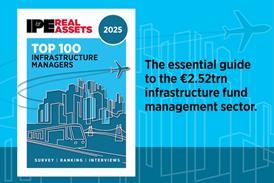The larger the REIT regime the more it can focus - just look at the US.
So where is Europe? Cue the EU-REIT. Piet Eichholtz and Nils Kok report
For pension funds and other investors, property is an important part of the portfolio, and many investors choose to build up their property exposure through publicly listed property companies. This market has grown substantially in the last two decades: from €28bn in the early 1980s to approximately €1.2trn in 2007.
To facilitate private savers and institutional investors, numerous countries have created special tax regimes for property companies, commonly called Real Estate Investment Trusts or REITs, so as to avoid double taxation, and to create a level playing field between different forms of real estate ownership. The goal of these regimes is to avoid taxing a rental income stream at the corporate level and again at the shareholder level. Thus, exemption from corporate tax for a property company puts the shareholder in such a property company in a comparable position with an investor who owns a property portfolio outright, since the rental stream for such an investor will only be taxed as income. In other words, corporate tax exemption creates a level playing field between the direct segment and the indirect segment of the property market. In this sense, such tax treatment of property companies is analogous to the corporate tax-exemption of mutual funds, for which a corporate tax levy would also entail double taxation.
Legislation regarding tax exemption of property companies is in flux: 13 out of the 27 EU member states now have some kind of tax-transparent regime for property companies, of which most have been introduced in the last five years. Once introduced, these regimes tend to be reformed quite frequently. Moreover, the exact form of these regimes varies widely - and seemingly arbitrarily - across countries, as Table 1 shows. This holds especially with respect to operational restrictions, leverage restrictions, and the question whether stock market listing is mandatory. There seems to be no standard towards which the tax-transparent regimes evolve.
The strongly varying nature of property share regimes across the EU keeps the market for indirect property investments fragmented. This fragmentation hinders competition among property companies from different EU member states, and even more so between property companies and direct property investors, who face no double taxation to begin with, and are far less restricted in their operations and financing.
The fragmented market situation in the EU contrasts markedly with the situation in the US, which has one and the same property share regime from coast to coast, enabling the development of a property share market that is now bigger than all of the EU's national property share markets combined. The market size created by this one legal regime enables property companies in the US to harvest economies of scale and scope that are out of reach for their European counterparts. For example, US property companies tend to be specialised in rather narrow product niches in the property market. The academic literature and empirical evidence presented in the report* show that this focus generally improves the creation of shareholder value.
This market scale also facilitates access to the capital market for fast-evolving semi-government sectors like senior housing, healthcare, and correctional property. Besides that, the efficient tax regime for US REITs provides fertile ground to spin off corporate real estate assets to institutional and private investors. It is very likely that specialised property investors add more value to their properties than do corporations and the government. Furthermore, these ‘new' investment property categories will bring additional diversification benefits for investors.
Contrary to the developments in the US, European property companies are mostly active in one member state only, and usually invest in a diversity of different property types, with office and retail property being the dominant investments. This precludes them from deep specialisation and does not foster an innovative property capital market.
An additional disadvantage of the current institutional situation is that it makes international property diversification less efficient, especially for investors from member states who do not have a tax-transparent property company regime in place, and for those from smaller member states. This obstacle to diversification also hinders efficient allocation of capital across EU member states, especially to the new member states in Central Europe.
For private and institutional investors in the EU to harvest the full potential of investments in the real estate market, it is important to have one uniform institutional setting for property companies, covering the European Union in its totality. To accomplish this uniform institutional setting, pan-EU regulation is of the utmost importance. Without such regulation, the EU's property share market will remain fragmented. The report shows that such a fragmented market leads to inefficient allocation of capital, which is particularly detrimental to small member states.
Introducing a pan-EU property company regime is not likely to produce significant tax losses for member states. Quite the contrary, the strongly increasing use of tax havens by listed property companies suggests that the market has already found ways to avoid double taxation. In the absence of a REIT regime, this development is likely to continue, and even expand. From a regulatory and supervisory point of view, however, the trend towards incorporation in tax havens is sub-optimal.
A pan-EU property company regime will support market safety and security. First, the introduction of a pan-EU property company regime would likely diminish the use of tax havens, which is beneficial for transparency. Second, although market integration has weakened the risk-spreading benefits of international diversification, the evidence in the report shows that the performances of different geographical property markets in Europe are still very dissimilar. This reduces risk, which is especially relevant in case of financial crises.
Third, REITs frequently have to turn to the capital market, due to the obligatory distribution of earnings. Therefore, they are subject to regular scrutiny by external agents, which reduces the conflict of interest between managers and investors. Fourth, the evidence in the report shows that the introduction of a REIT-like structure lowers the use of debt in property companies. Especially in the light of the current crisis on the debt market, it is clear that lower debt levels increase financial security for investors.
The academic literature and additional empirical evidence presented in the report provide strong and fundamental arguments for the creation of an EU REIT. To offer guidance in creating such a structure, the report also presents the key components of a blueprint for a pan-EU regime for property companies, addressing governance issues, operational and financial requirements, and other structural issues. There is abundant academic literature regarding property companies, their operations, performance, and governance. This literature, combined with best practice experience that can be observed in the US and European listed property markets, can lead the way towards an optimal regime for an EU REIT. Table 2 provides the key characteristics of a blueprint for such a regime. The EU-REIT regime should leave maximum freedom for the management of property companies to engage in value creation for their shareholders. This would mean, among others, that restrictions on leverage and share ownership should be avoided, and that would also hold for mandatory listing of property company shares, and for portfolio diversification rules. Property development by EU REITs should be allowed, but taxed in such a way that a level playing field with pure property developers is maintained. Lastly, the EU REIT should have a closed-end structure and we strongly advise that internal management be allowed.
Creating an EU REIT along these lines would turn the current fragmented EU market for property companies into the largest and likely most efficient property share market in the world. Investors, small and large, private and institutional, would greatly benefit from that.
* The EU REIT and the Internal Market for Real Estate: a research report for the European Landowners' Organisation, the European Property Federation, the Royal Institution of Chartered Surveyors, The European Group of Valuers' Associations, and the Urban Land Institute Europe
Piet Eichholtz, professor of fnance and real estate, University of Maastricht
Nils Kok, department of finance, University of Maastricht












